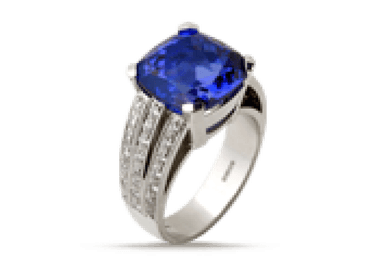Tanzanite
Found in just one place on earth, tanzanite is a relatively recent discovery. Tiffany & Co named this blue-violet variety of zoisite in honor of Tanzania, where it was first unearthed in 1967.
History
Tanzanite is relatively new to the colored stone galaxy. As the most common story of the tanzanite mining boom goes, in 1967 a Masai tribesman stumbled upon a cluster of highly transparent, intense violet-to-blue crystals weathering out of the earth in Merelani, an area of northern Tanzania. He alerted a local fortune hunter named Manuel d'Souza, who quickly registered four mining claims.
Facts
Quality Factors
Tanzanite, as with Diamonds, and all gemstones alludes to the 4 C’s of quality - CARAT, COLOR, CLARITY AND CUT. These are where you look to judge quality in a Tanzanite.

Carat
Tanzanite color is less saturated in smaller sizes. Gems must be above five carats in size to have fine color.
Learn more
Color
Deep saturated violet blue or blue violet are the most valuable tanzanite colors. Paler hues are more commonly found.
Learn more
Clarity
Eye-visible inclusions decrease the value of tanzanite, particularly in lighter colored stones
Learn more
Cut
Tanzanite is available in a wide range of shapes but cushion and oval cuts are most common.
Learn moreLighting & How It Affects
The grading standard for all colored gems and Diamonds is North Daylight Equivalent which is around 5,500 kelvin.
Why We Love This Gemstone
Pleochroic
One Place on Earth
Rich Blue
Our Gallery
Our main advantage is the control of the entire process, from mining, cutting, setting into jewellery, to the final sale.

